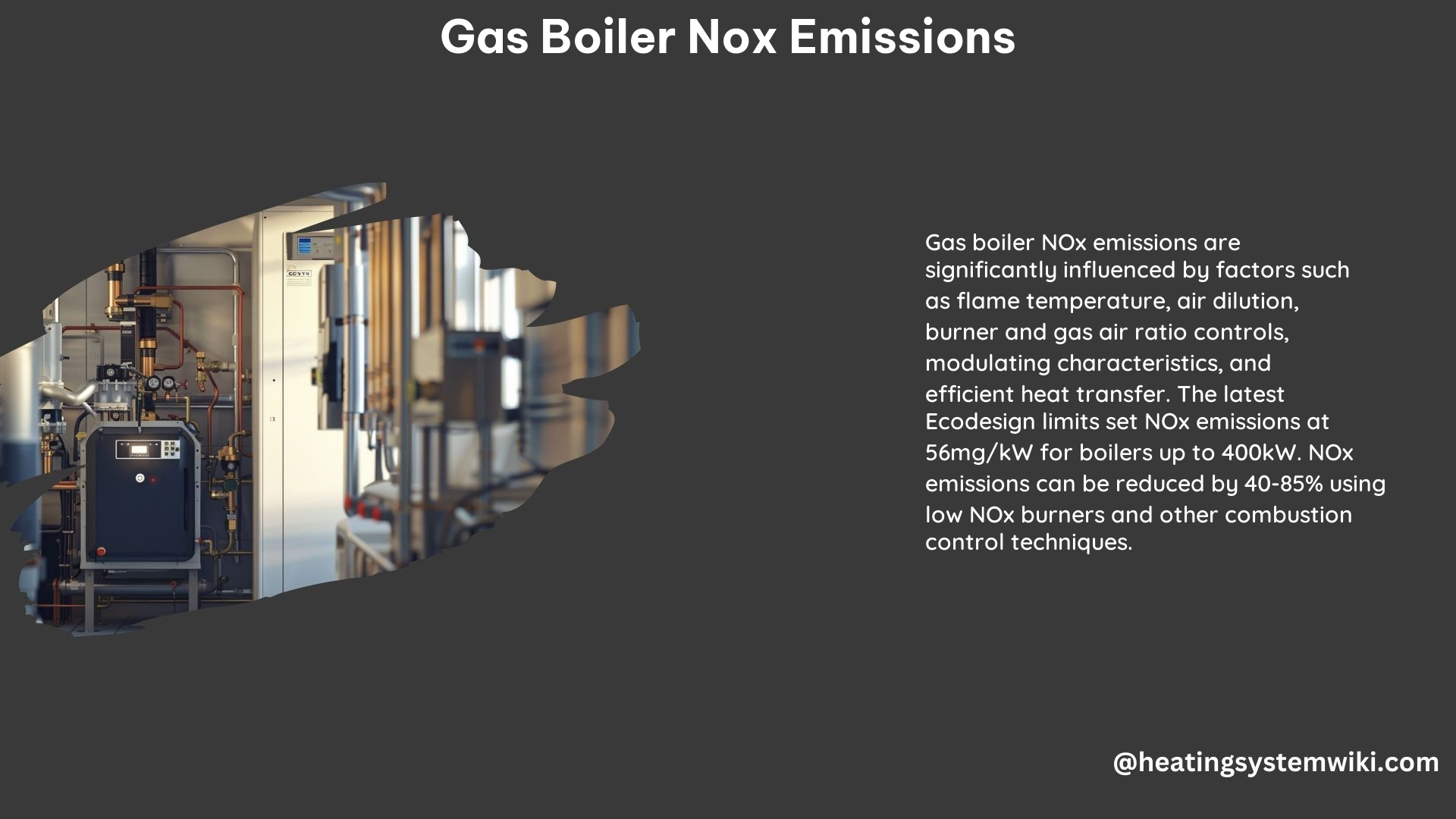Gas boilers are a common heating source in many households and commercial buildings, but they can also contribute significantly to urban air pollution through the emission of nitrogen oxides (NOx). Understanding the sources, impact, and regulations surrounding gas boiler NOx emissions is crucial for improving air quality and mitigating the associated health risks.
What are the main sources of NOx emissions from gas boilers?
The primary mechanisms of NOx formation in gas boilers are:
- Thermal NOx Formation:
- This is the dominant source of NOx emissions from gas boilers.
- Occurs when nitrogen and oxygen in the combustion air combine at high temperatures in the flame.
-
Factors influencing thermal NOx include:
- Flame temperature: Higher temperatures increase NOx emissions. Typical flame temperatures in gas boilers range from 1,600°C to 1,900°C.
- Air dilution (λ value): Higher air-to-fuel ratios (λ values) lower the flame temperature, reducing NOx emissions. Typical λ values for gas boilers range from 1.1 to 1.3.
- Burner and gas air ratio controls: Optimizing the mix of air and fuel can improve NOx emissions. Modern gas boilers often use advanced burner technologies and control systems to minimize NOx formation.
- Modulating characteristic: Boilers firing at lower rates have lower NOx emissions compared to full capacity operation. This is due to the reduced flame temperature at part-load conditions.
- Efficient heat transfer: Lowering the flame temperature through efficient heat transfer, such as using condensing boiler technology, can reduce NOx emissions.
-
Fuel NOx Formation:
- This occurs when nitrogen in the fuel reacts with oxygen in the combustion air.
- Fuel NOx is less significant for gas boilers compared to other fuels, as natural gas has a low nitrogen content (typically less than 0.1% by volume).
How do gas boilers contribute to urban air pollution?

- NOx Emissions: Gas boilers are a significant source of NOx emissions, contributing approximately 21% of total NOx emissions in urban areas like Greater London.
- According to the ECIU report, gas boilers in the UK emit around 80,000 tonnes of NOx per year, equivalent to the emissions from 35 million cars.
-
The average NOx emission rate for gas boilers in the UK is around 40-60 mg/kWh, with some older models emitting up to 100 mg/kWh.
-
Increased Emissions during Pandemics:
- Changes in work patterns, such as increased working from home during the COVID-19 pandemic, can lead to a 56% rise in gas boiler use, resulting in higher NOx emissions and compromised air quality.
-
A study by the ECIU found that the shift to remote working during the pandemic led to a significant increase in domestic gas boiler usage, with a corresponding rise in NOx emissions.
-
Health Impacts:
- NOx emissions from gas boilers have significant health implications, including increased respiratory hospital admissions, chronic mortality, diabetes, asthma, and lung cancer.
- According to the World Health Organization, exposure to NOx can cause inflammation of the airways, reduced lung function, and increased risk of respiratory conditions.
What are the current regulations for NOx emissions from gas boilers?
- Ecodesign Regulations:
- The latest Ecodesign regulations, effective from September 2018, set a limit of 56 mg/kWh for NOx emissions from natural gas boilers up to and including 400 kW.
-
This regulation aims to drive the development and adoption of more efficient and low-emission gas boiler technologies.
-
BS EN 15502:
- This European standard provides a methodology for measuring NOx emissions from commercial boilers, ensuring accurate comparisons between manufacturers.
-
The standard specifies a weighting formula to create an annualized emission figure, corrected to reference conditions of 0% O2 (dry air).
-
New Source Performance Standards (NSPS):
- The Federal EPA in the United States has established NSPS for industrial boilers, regulating NOx, SOx, and particulate matter emissions based on boiler size and fuel type.
- The NSPS limits for NOx emissions from natural gas-fired boilers range from 30 ppm to 96 ppm, depending on the boiler size and configuration.
Technical Specification of Gas Boiler NOx Emissions
- Measurement Methodology:
- As mentioned, the BS EN 15502 standard provides a weighting formula to create an annualized emission figure, corrected to reference conditions of 0% O2 (dry air).
-
This ensures consistent and accurate measurement of NOx emissions from commercial boilers, allowing for meaningful comparisons between different models and manufacturers.
-
Emission Factors:
- The emission factor is used to calculate the total annual NOx emissions from a gas boiler, taking into account the boiler input, annual hours of operation, and the measured NOx levels.
-
Typical emission factors for natural gas-fired boilers range from 0.1 to 0.5 kg NOx/GJ of fuel input, depending on the boiler type and emission control technologies employed.
-
Control Technologies:
- Various technologies are used to reduce NOx emissions from gas boilers, including:
- Low NOx burners: These burners are designed to minimize the formation of thermal NOx by controlling the air-fuel mixture and flame characteristics.
- Staged combustion: This technique involves dividing the combustion process into primary and secondary stages, reducing peak flame temperatures and NOx formation.
- Gas reburning: This method involves injecting a portion of the fuel downstream of the primary combustion zone, creating a reducing environment that can convert NOx to molecular nitrogen.
By understanding the sources, impact, and regulations surrounding gas boiler NOx emissions, building owners, facility managers, and policymakers can make informed decisions to improve air quality and protect public health. Implementing the latest emission control technologies and adhering to regulatory standards can play a crucial role in mitigating the environmental and health consequences of gas boiler NOx emissions.
References:
- Hamworthy Heating. (n.d.). The whats, hows and whys of NOx emissions in commercial boilers. Retrieved from https://hamworthy-heating.com/Knowledge-portal/Article-library/NOx-emissions-from-commercial-boilers
- ECIU. (2020). Gas boilers and NOx: the hidden emitter. Retrieved from https://ca1-eci.edcdn.com/Gas-boilers-and-NOx-the-hidden-emitter.pdf?v=1603351014
- CleanBoiler.org. (n.d.). Boiler Combustion. Retrieved from http://cleanboiler.org/learn-about/boiler-efficiency-improvement/boiler-combustion/
- Environmental Protection Agency (EPA). (2020). 1.4 Natural Gas Combustion. Retrieved from https://www.epa.gov/sites/default/files/2020-09/documents/1.4_natural_gas_combustion.pdf
- ECIU. (2020). Gas boilers and NOx: the hidden emitter. Retrieved from https://eciu.net/analysis/reports/2020/gas-boilers-and-nox-the-hidden-emitter
